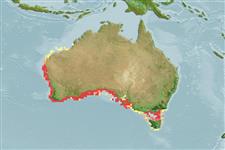Environment: milieu / climate zone / depth range / distribution range
Ökologie
seewasser; brackwasser demersal; tiefenbereich 1 - 30 m (Ref. 9563). Subtropical; - 45°S
Eastern Indian Ocean: known only from southern Australia, from Western Australia to Victoria and Tasmania. Large adults have been misidentified as Platycephalus fuscus, the common estuarine flathead of New South Wales and southern Queensland (Ref. 9563).
Length at first maturity / Size / Gewicht / Alter
Maturity: Lm 32.5 range ? - ? cm
Max length : 90.0 cm TL Männchen/unbestimmt; (Ref. 9563)
Rückenflossenstacheln (insgesamt) : 8 - 9; Rückenflossenweichstrahlen (insgesamt) : 13 - 14; Afterflossenstacheln: 0; Afterflossenweichstrahlen: 13 - 14; Wirbelzahl: 27. Adults have 3-5 large round black spots with white margins on the lower-half of the caudal fin.
A shallow water species, recorded from surf beaches, estuaries and in bays (Ref. 9563).
Paxton, J.R., D.F. Hoese, G.R. Allen and J.E. Hanley, 1989. Pisces. Petromyzontidae to Carangidae. Zoological Catalogue of Australia, Vol. 7. Australian Government Publishing Service, Canberra, 665 p. (Ref. 7300)
IUCN Rote Liste Status (Ref. 130435: Version 2024-1)
Bedrohung für Menschen
Harmless
Nutzung durch Menschen
Fischereien: nicht kommerziell
Tools
Zusatzinformationen
Download XML
Internet Quellen
Estimates based on models
Preferred temperature (Ref.
123201): 15.7 - 23.8, mean 18 °C (based on 215 cells).
Phylogenetic diversity index (Ref.
82804): PD
50 = 0.5000 [Uniqueness, from 0.5 = low to 2.0 = high].
Bayesian length-weight: a=0.00457 (0.00230 - 0.00908), b=3.09 (2.91 - 3.27), in cm total length, based on LWR estimates for this (Sub)family-body shape (Ref.
93245).
Trophic level (Ref.
69278): 4.0 ±0.4 se; based on diet studies.
Generation time: 3.3 (2.5 - 4.4) years. Estimated as median ln(3)/K based on 11
growth studies.
Widerstandsfähigkeit (Ref.
120179): mittel, Verdopplung der Population dauert 1,4 - 4,4 Jahre. (tm=1-2; tmax=12).
Fishing Vulnerability (Ref.
59153): Low to moderate vulnerability (35 of 100).
Nutrients (Ref.
124155): Calcium = 129 [10, 478] mg/100g; Iron = 1.84 [0.49, 4.79] mg/100g; Protein = 18.4 [16.1, 20.6] %; Omega3 = 0.299 [0.133, 0.836] g/100g; Selenium = 46.7 [12.9, 165.9] μg/100g; VitaminA = 7.74 [3.19, 18.47] μg/100g; Zinc = 0.841 [0.391, 1.706] mg/100g (wet weight);
